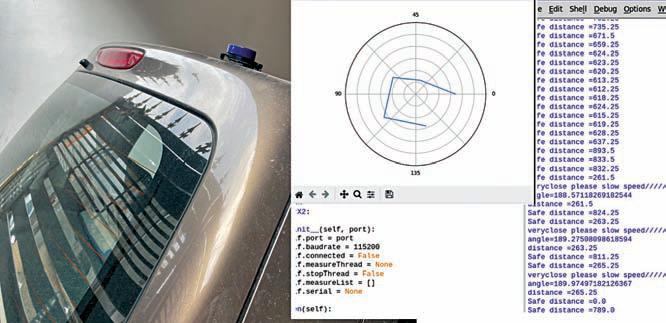
These use proximity sensors, cameras, and/or a lidar system. This project proposes to build a simple anti-collision system with a lidar.
Fig. 1 shows the lidar mounted on a car, along with the data generated by it for giving an alert. The components required to build the project are mentioned under Table 1.
You can use any lidar that is compatible with Python and has a Python SDK module for development, such as RPi lidar, YDLIDAR, Intel Real Sense lidar, and Velodyne lidar. The price of lidars available in the market varies considerably and so does their detection range. Most of them use USB serial communication.
In our design, we used YDLIDAR X2, but you can use any of the above-mentioned lidars. However, it is important to go through the datasheet (can search on Google) of the lidar and the Python module you are using to create the code around them.
In the datasheet, we can see the table that tells us that the field of view of this lidar is 360 degrees. So, this lidar can sense in any direction as it uses a motor to rotate. Some lidars provide 250- or 180-degree coverage only, so you need to choose the lidar as per your need.
The second important aspect of a lidar is its range and the conditions under which it can work. Some lidars use IR laser or red laser to work, some use doppler waves, and some others may be using yet another technology. So, to design a solution that works even in a foggy or rainy environment, we need to select the lidar accordingly.
In our design we have used laser-based YDLIDAR X2, whose parameters are given in Table 2 and whose image is shown in Fig. 2.
この記事は Electronics For You の June 2023 版に掲載されています。
7 日間の Magzter GOLD 無料トライアルを開始して、何千もの厳選されたプレミアム ストーリー、9,000 以上の雑誌や新聞にアクセスしてください。
すでに購読者です ? サインイン
この記事は Electronics For You の June 2023 版に掲載されています。
7 日間の Magzter GOLD 無料トライアルを開始して、何千もの厳選されたプレミアム ストーリー、9,000 以上の雑誌や新聞にアクセスしてください。
すでに購読者です? サインイン

TRULY INNOVATIVE ELECTRONICS -INNOVATION UPDATES
Amongst numerous press releases of new products received by us, these are the ones we found worthy of the title Truly Innovative Electronics

Elastomer enhancing smart wearable performance
A high-tech, flexible wearable device made from the innovative elastomer material

Nanotechnology based noninvasive cancer diagnostics
Nanoflake sensors built from indium oxide with platinum and nickel detect changes in isoprene

Space communication with silent amplifiers
In the new communication system from researchers at Chalmers University of Technology, in Sweden, a weak optical signal (red) from the spacecraft's transmitter can be amplified noisefree when it encounters two so-called pump waves (blue and green) of different frequencies in a receiver on Earth.

Advancements in TOPCon solar cells
The structure and performance of tandem devices with highly passivated TOPCon bottom cells

Quantum leap in magnetism refines superconductors
Rice University physicists have uncovered key magnetic and electronic properties in kagome magnets, structures resembling basket-weaving patterns.

Sensor targets food antioxidants
A research team from Hunan City University and Xiangtan University in China has developed a sensor for detecting TBHQ, a food antioxidant used in oils and fats, addressing health concerns at high concentrations.

Data sensing with repurposed RFID tags
UC San Diego researchers have advanced passive data collection with a breakthrough in battery-free sensing.

Seal-inspired sensors to safeguard offshore wind farms
Schematic structure of the seal whisker-inspired flow sensors

Artificial nose identifies scents accurately
Artificial nose identifies scents accurately